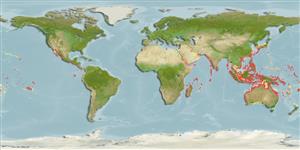Common names from other countries
Teleostei (teleosts) >
Syngnathiformes (Pipefishes and seahorses) >
Solenostomidae (Ghost pipefishes)
Etymology: Solenostomus: Greek, solen = tube + Greek, stoma = mouth (Ref. 45335).
More on author: Pallas.
Environment: milieu / climate zone / depth range / distribution range
Ecology
Marine; reef-associated; depth range 4 - 35 m (Ref. 90102). Tropical
Indo-West Pacific: Red Sea and East Africa to Fiji, north to southern Japan, south to southeast Australia and New Caledonia. Recently recorded from Tonga (Ref. 53797).
Size / Weight / Age
Maturity: Lm ? range ? - ? cm
Max length : 12.0 cm TL male/unsexed; (Ref. 2334)
Dorsal spines (total): 5; Dorsal soft rays (total): 17 - 21; Anal spines: 0; Anal soft rays: 17 - 21; Vertebrae: 32 - 33. Post-pelagic are almost fully transparent and more slender compared to those established in the benthic phase. Variable in color from black to red and yellow, usually in a mix of bands and spots (Ref. 48635). Total body number of plates 31-35. Caudal fin truncate, rounded or lanceolate. Caudal fins of females modified into brood pouch (Ref. 9829).
Adults usually settle along reef edges in current-prone areas (Ref. 48635). Uncommon species found solitary or paired, among branches of gorgonians, floating weeds, or crinoids (Ref. 9710). They feed mostly on mysids but also target small benthic shrimps (Ref. 48635). Females carry the eggs in their pelvic fins that are modified to form a brood pouch (Ref. 205).
Life cycle and mating behavior
Maturities | Reproduction | Spawnings | Egg(s) | Fecundities | Larvae
Pelvic fins of females are modified as brood pouch for the reception of the eggs (Ref. 205).
Randall, J.E., G.R. Allen and R.C. Steene, 1990. Fishes of the Great Barrier Reef and Coral Sea. University of Hawaii Press, Honolulu, Hawaii. 506 p. (Ref. 2334)
IUCN Red List Status (Ref. 130435)
CITES (Ref. 128078)
Not Evaluated
Threat to humans
Harmless
Human uses
Fisheries: of no interest; aquarium: public aquariums
Tools
Special reports
Download XML
Internet sources
Estimates based on models
Preferred temperature (Ref.
115969): 20.9 - 29, mean 27.7 (based on 626 cells).
Phylogenetic diversity index (Ref.
82804): PD
50 = 0.5312 [Uniqueness, from 0.5 = low to 2.0 = high].
Bayesian length-weight: a=0.01000 (0.00244 - 0.04107), b=3.04 (2.81 - 3.27), in cm Total Length, based on all LWR estimates for this body shape (Ref.
93245).
Trophic level (Ref.
69278): 3.6 ±0.59 se; based on food items.
Fishing Vulnerability (Ref.
59153): Low vulnerability (10 of 100).
